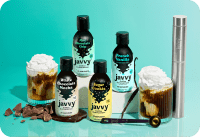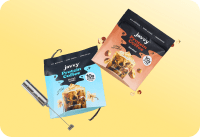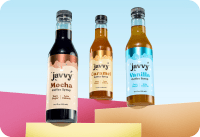
The Complete Guide to Smooth, Low‑Acid Cold Brew Concentrates
What Is Cold Brew Concentrate?
Cold brew concentrate is made by steeping coarsely ground coffee in cold or room-temperature water for 12-24 hours, then filtering to obtain a thick liquid with 4-7% total dissolved solids (TDS).
Key characteristics of cold brew concentrate include:
What Are the Benefits of Coffee Concentrate?

Coffee concentrate is the easiest way to get great coffee (fast). Because it’s pre-brewed and ultra-flavorful, you just add water or milk and you’re sipping in seconds (iced or hot).
It’s naturally smoother and lower in perceived acidity than many hot brews, so it tastes rounder and is easier on the palate. You also get consistency: every pour starts from the same strong base, which means fewer “oops” cups.
Coffee concentrate is versatile. You can dial strength with simple ratios (1:3 for iced coffee, 1:2 for lattes), or use it in cocktails, baking, sauces, and protein shakes without introducing extra bitterness. It’s efficient too, with less gear, less mess, and less wasted beans compared to brewing a full pot you don’t finish. Stored in the fridge, it keeps well, so you can batch (or buy) once and enjoy all week.
How Does Cold Extraction Reduce Acidity?
Cold water extraction is gentler on your beans and your taste buds.
Brewing cool pulls out fewer chlorogenic acids and other acidic stuff, so the flavor stays smooth and rounded. It also slows how quickly caffeine and organic acids dissolve, which is why cold brew feels softer and more balanced in the mouth.
Fun fact: Cold brew usually sits around pH 6.0-6.5, while hot coffee is closer to 5.0-5.5.
Cold Brew Versus Hot Brew and Espresso
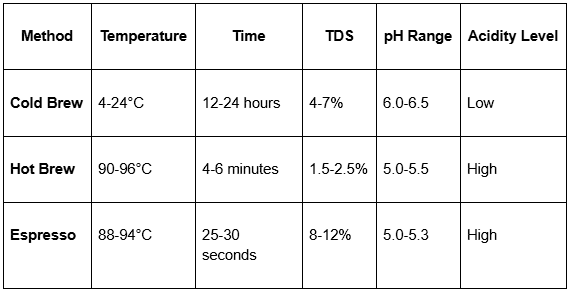
Cold brew's longer extraction time compensates for lower temperature, resulting in higher TDS and lower acidity.
Typical Caffeine and TDS Levels
Cold brew concentrate is mighty by design. One 30 ml serving usually lands around 150-200 mg of caffeine. Mix it 1:3 with water or milk, and you’ll get roughly 50-65 mg per 8-oz cup, which is right in the zone of a regular coffee, minus the harshness.
The sweet spot sits around a TDS range of ~4-7% so flavors stay bold, clean, and balanced.
What Affects Coffee Concentrate Flavor and Acidity?
Coffee flavor and acidity come down to a few basics, like pH, the beans and roast, brew time, and water quality.
Your ratio (coffee to water) and any dilution set the strength. Fresh beans and clean, mineral-balanced water keep the cup clear and consistent. Adjust these levers to make your coffee smoother, sweeter, or brighter.
pH and Total Dissolved Solids
pH levels affect perceived acidity and flavor. Cold brew maintains a pH of 6.0‑6.5, offering a gentler taste.
Total dissolved solids (TDS) contribute to body and smoothness, with the ideal range of 4‑7% TDS providing:
Higher TDS levels enhance viscosity and sweetness, while lower levels may taste thin.
Bean origin and variety impact
Arabica beans are preferred for cold brew due to their naturally lower bitterness. Optimal bean origins include:
These beans naturally produce lower chlorogenic acid levels, ideal for smooth concentrates.
Roast level effects on acidity and bitterness
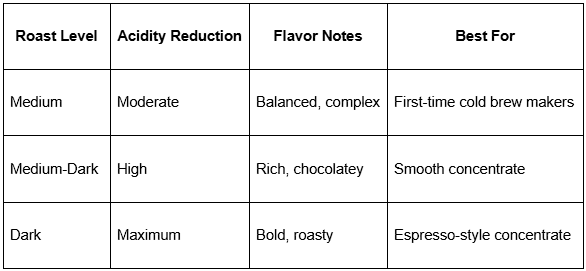
Water chemistry and filtration
Water quality impacts extraction and flavor. Ideal hardness is 50‑150 ppm calcium carbonate:
For the best flavor, focus on using:
You’ll generally want to avoid distilled water (flat) and hard tap water (harsh flavors). Proper water chemistry ensures consistent extraction and helps maintain the low-acid profile.
How To Choose the Right Beans and Roast for Low‑Acid Brew
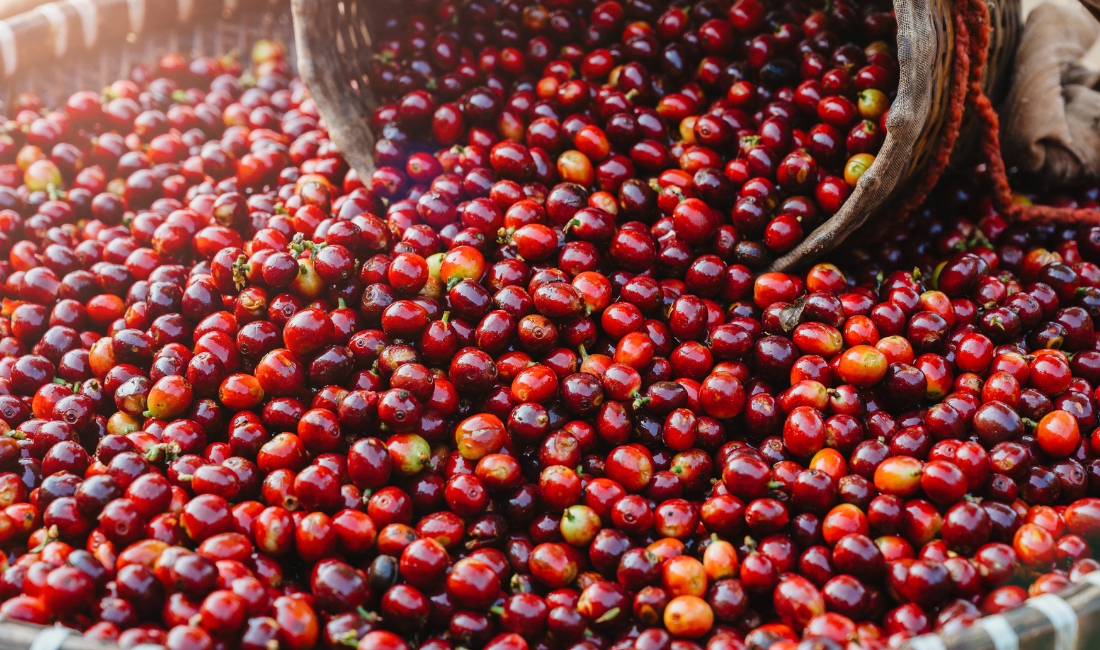
Choosing beans for a low-acid brew is key. Here’s a general look at what to keep in mind.
Low‑acid bean profiles
Selecting low-acid beans is crucial for smooth cold brew concentrate. Top varieties include:
These beans have lower chlorogenic acid content, enhancing sweetness and body.
Medium vs. dark roast for smoothness
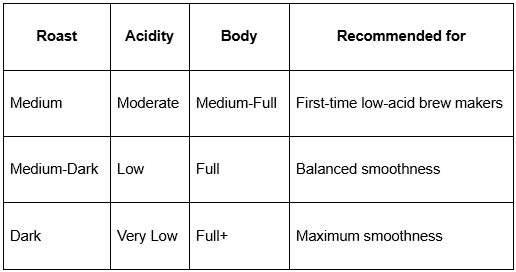
Single origin versus blends
Single origin coffees showcase unique flavors, while blends balance acidity, body, and flavor consistency.
Master roasters create:
Blends often provide better consistency for commercial production, while single origins appeal to specialty markets.
Freshly roasted versus pre‑ground
Freshly roasted beans maximize flavor. For optimal results:
Pre-ground coffee may lose flavor, increasing bitterness. Use only if:
Investing in fresh beans pays off in concentrate quality.
Can You Make Your Own Low‑Acid Cold Brew Concentrate?
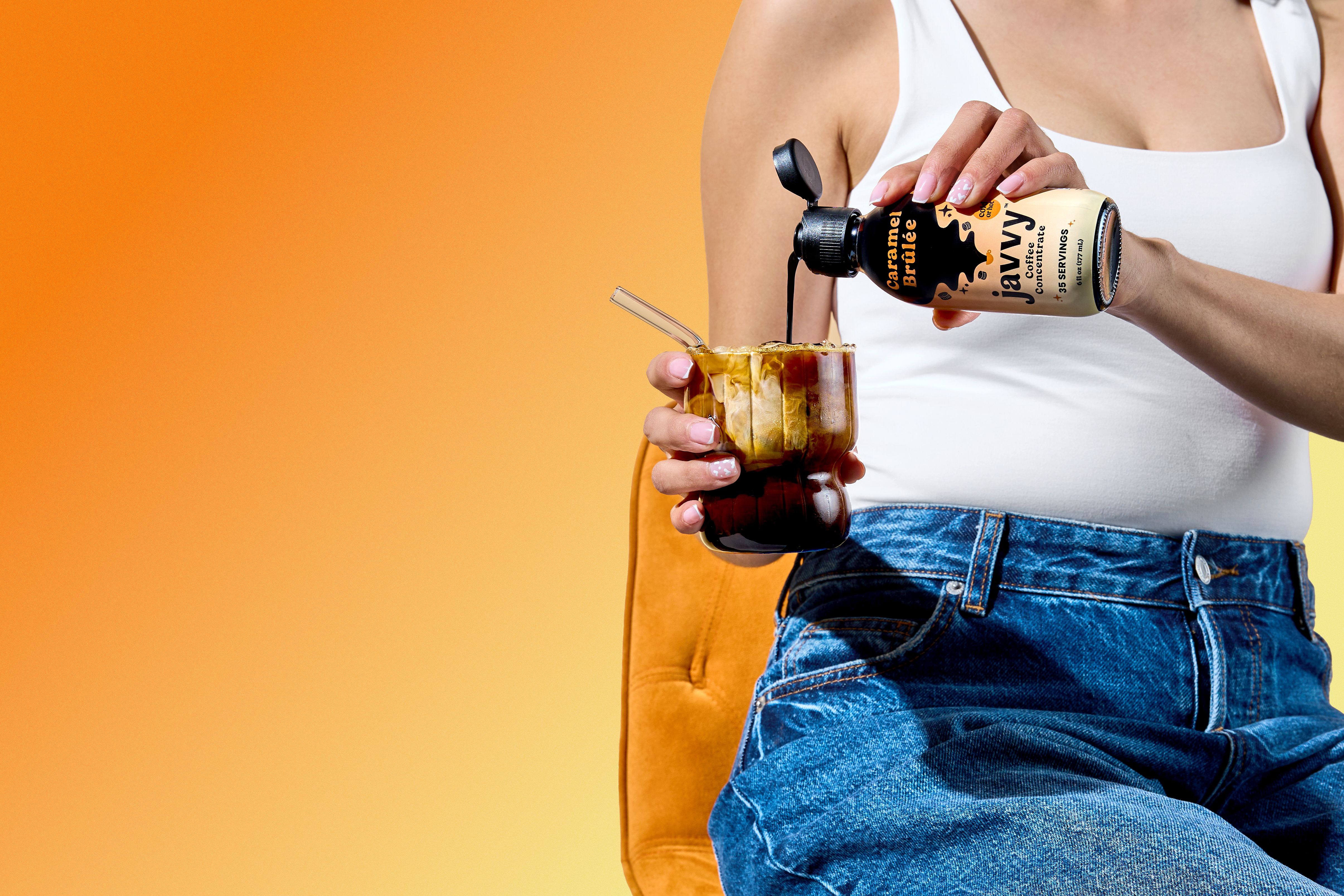
With a bit of kitchen skills, you can technically make your own low-acid cold brew concentrate at home — though it may not have the same volume of flavor as high-quality brands like Javvy!
You’ll need:
For concentrate, focus on a 1:4 ratio of coffee to water by weight (ex: 125 g coffee to 500 g water). For ready-to-drink cold brew, dilute your concentrate 1:3 to 1:4 with water or milk.
Grind Beans and Add Water
Start by grinding your beans to a coarse texture — think sea salt or breadcrumbs. A coarse grind slows extraction and helps keep acids in check. Add grounds to your jar, pour in filtered water, and stir to fully wet the coffee.
Cap the jar and let it steep at room temperature for 12-16 hours or in the fridge for 16-24 hours. Cooler, slower brews tend to taste rounder and less sharp.
Strain and Taste
When time’s up, strain. If you used a French press, press gently; don’t force it. For the cleanest cup, run the brew through a paper filter or a tight-weave bag. Less fine sediment = smoother mouthfeel and fewer bitter notes over time.
Taste your concentrate. It should be bold but not harsh. If it’s too sharp, the next batch can go a touch coarser or steep for an additional two to four hours. If it’s flat or woody, shorten the steep or use slightly fresher beans. Store the strained concentrate in a sealed container in the fridge for up to 7-10 days.
To serve, start with 1 part concentrate to 3 parts water or milk, then adjust. Ice will naturally dilute, so don’t be shy about making your first sip a little stronger.
Want it to be extra smooth? Add your favorite creamer or a pinch of salt to round out the edges.
Quick Tips
We’ve got a few extra tips for the best experience:
Storing and Maintaining Coffee Concentrate
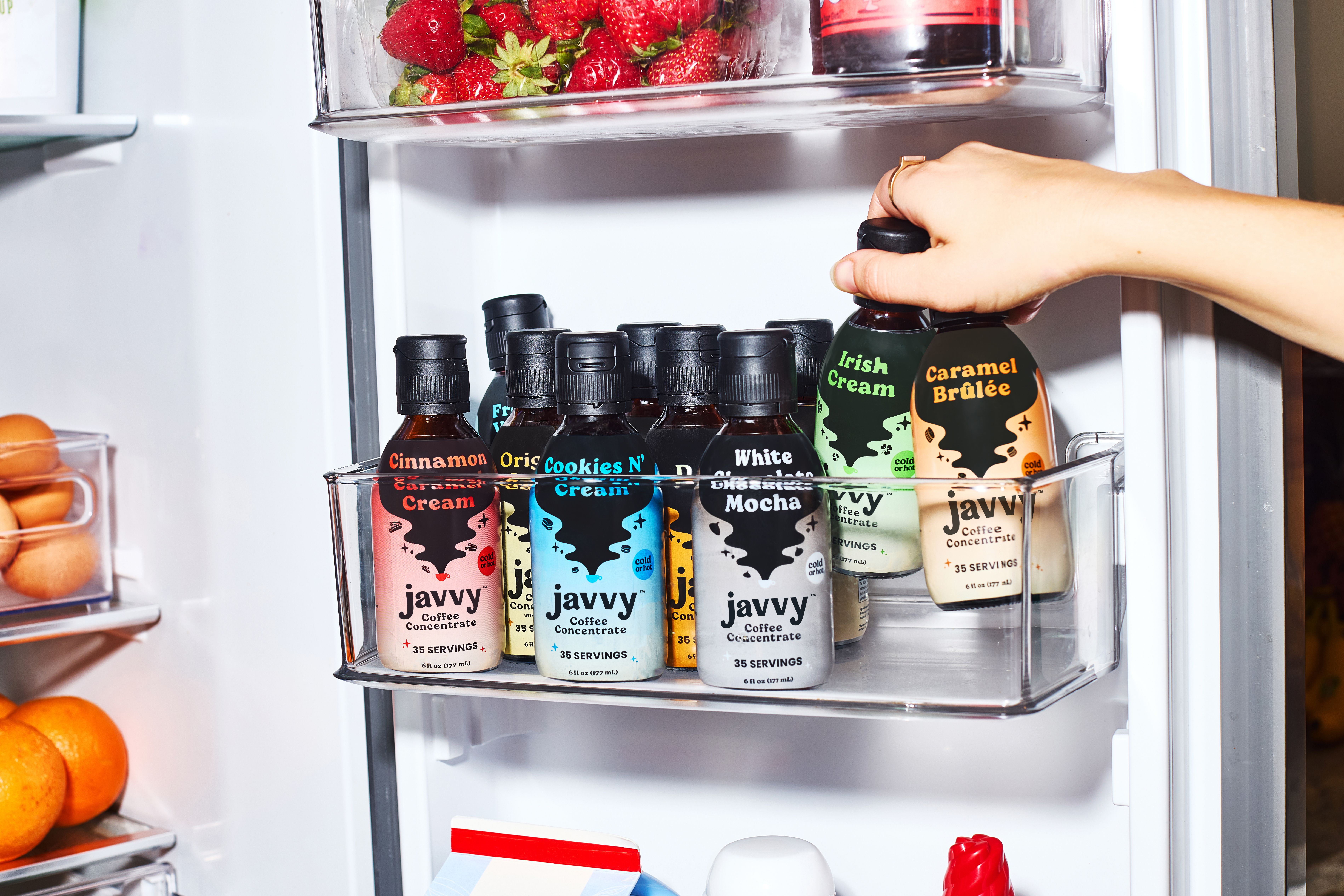
A little care goes a long way toward keeping your concentrate tasting clean and balanced. Store it cold, keep air and light out, and use it within its best-by window.
Ideal Refrigeration Practices
Keep your concentrate in the fridge at 2-4°C (cold, but not freezing). Try to avoid temperature swings from frequent door opening — steady temps help preserve flavor.
Pour into a container that seals tightly and fills up most of the way to minimize headspace (less oxygen = less staling). Label the jar with the brew date so you know when it’s at its peak.
Need more time? Freeze portions so you only thaw what you’ll use.
Choosing a Container
Dark glass and stainless steel are ideal, as they block light and don’t hold onto odors.
Skip clear plastic (lets light in) and regular plastic that can absorb or leach smells over time. Whatever you use, airtight seals are the real hero against oxygen.
Refreshing Stale Concentrate
You can “refresh” a tired batch: brew a fresh cold brew using the same beans and ratio, then blend 1:1 (stale:fresh) and pass it through a fine filter. It’ll perk things up, but nothing beats a truly fresh concentrate.
Javvy Coffee: Your Shortcut to the Perfect Cup

Looking for delicious cold brew concentrate without the hassle of making it yourself? Rely on Javvy Coffee to please your taste buds (and your inner coffee snob). For café-quality coffee in seconds, our Coffee Concentrates are the easy button: add 1-2 tsp to water or milk and you’re sipping (iced or hot) in no time.
Pick from fan favorites like Original, Sugar Cookie, Caramel Brûlée, and more, with bundle savings when you stock up. Crafted with better-for-you ingredients, our concentrates use 100% natural Arabica beans and natural flavors, with no synthetics, artificial preservatives, added colors, or GMO ingredients… and they’re gluten- and dairy-free!
Each teaspoon delivers about 60-80 mg of caffeine (similar to a typical cup).
Low‑Acid Coffee Concentrate Drink Ideas
Low-acid cold brew concentrate is a flexible base you can tune to your taste — iced, hot, cocktail… or dessert.
Dilution Ratios for Iced Coffee and Lattes
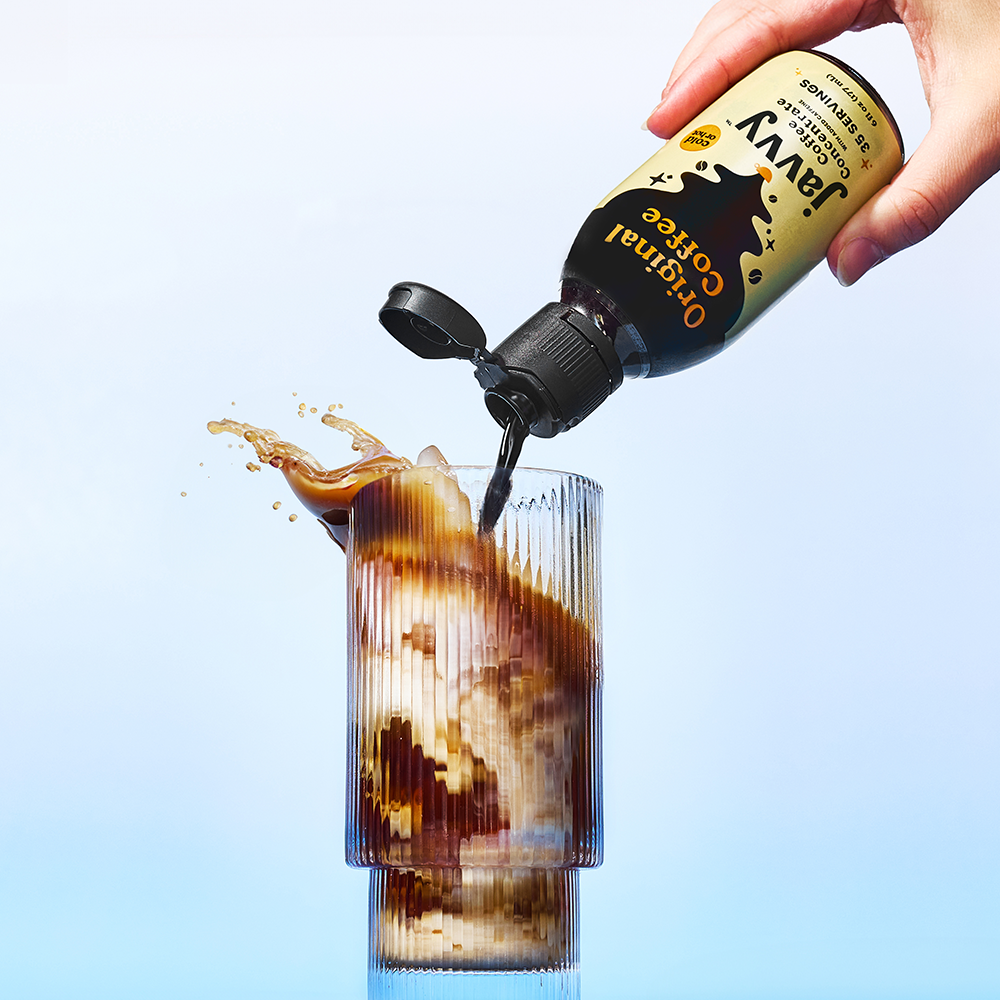
For everyday iced coffee, go 1 part concentrate to 3 parts cold water (i.e., 60 ml concentrate + 180 ml water over ice). It’s smooth, balanced, and gentle on the stomach. Prefer a creamier sip? For a cold brew latte use 1:2 with milk (i.e., 60 ml concentrate + 120 ml milk).
Hot Coffee
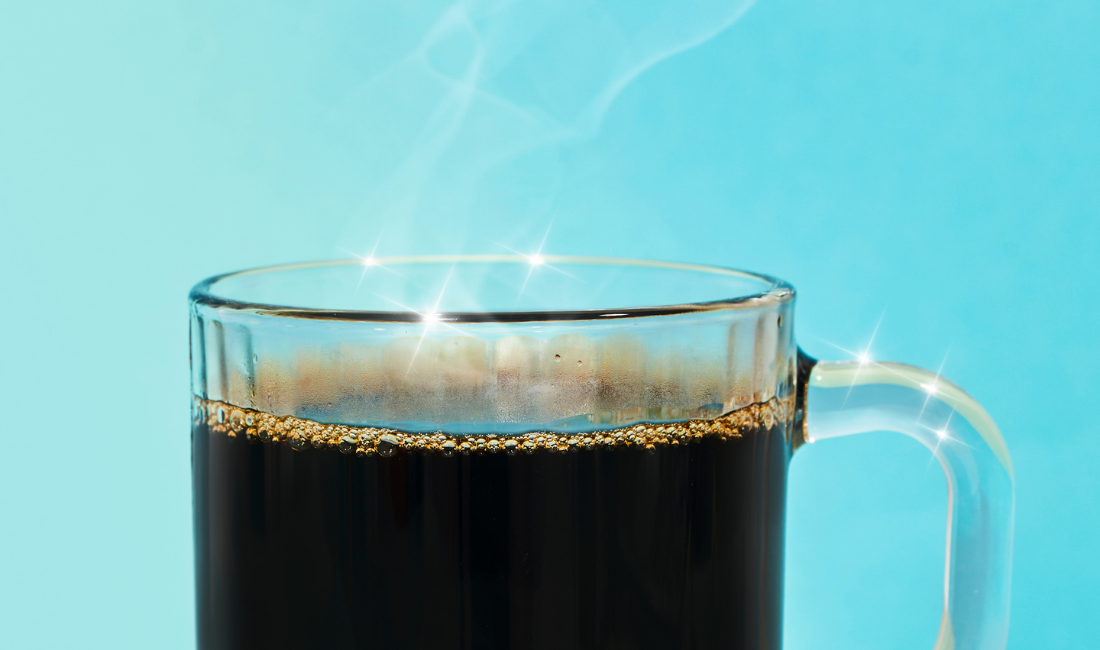
Yes, you can make a low-acid hot cup. Warm the concentrate gently (≤70°C / 160°F) and combine 1:1 with hot water.
For café vibes at home:
Coffee‑Based Cocktail Ideas
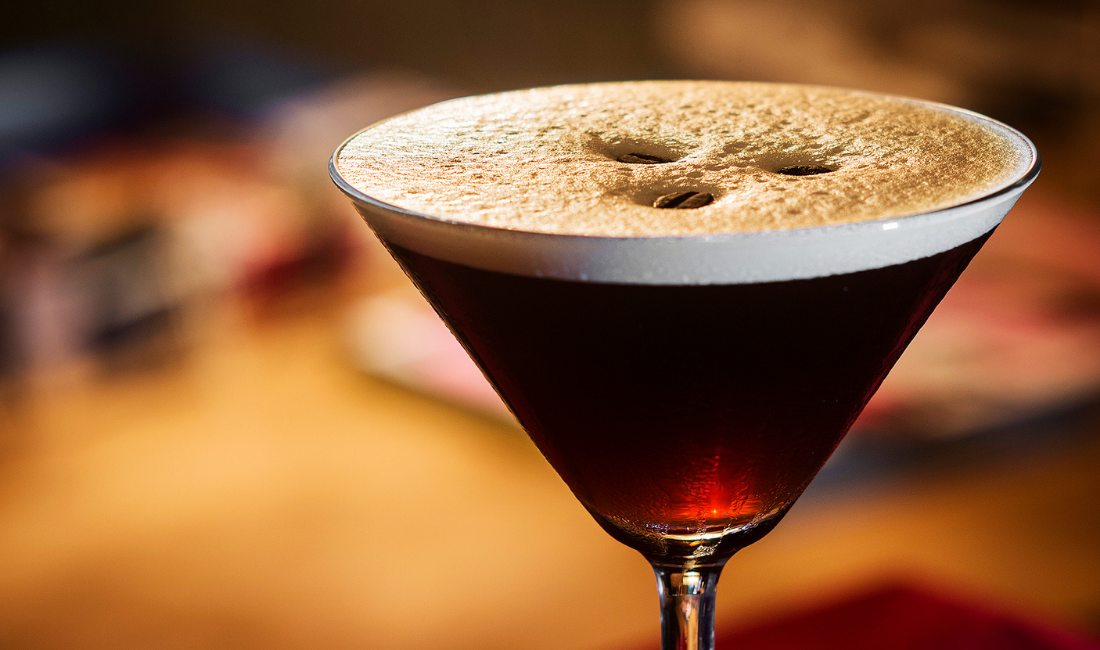
Concentrate brings depth without harsh edges, making it perfect for mixing.
Baking Ideas
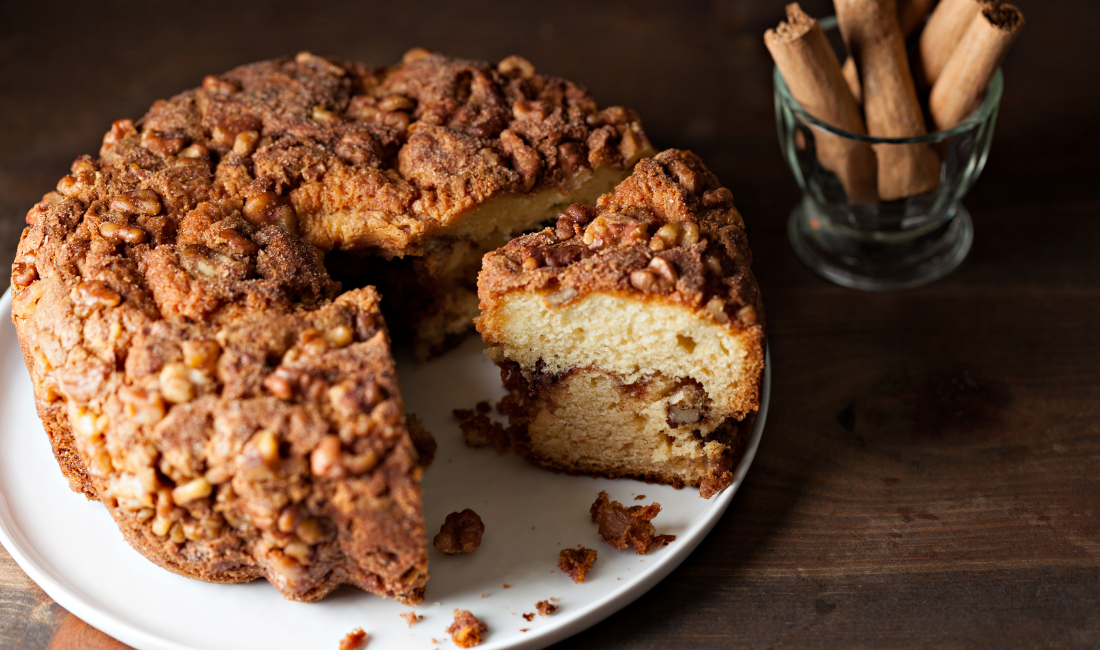
Use concentrate to add coffee richness without extra acidity.
The Bottom Line
Coffee concentrates have taken off for a simple reason: they make great coffee effortless. One bottle gives you a smooth, low-acid base that’s ready for anything (iced, hot, latte, cocktail, or baking) without extra gear or guesswork.
You control the strength with quick ratios, so every cup is consistent and tailored to your taste. They’re efficient, too: batch once, store in the fridge, and pour all week with less waste and less mess. Add in flavor variety and you’ve got café flexibility at home, from classic and chocolatey to bakery-sweet profiles.
That mix of convenience, consistency, and customization is why concentrates are showing up in more fridges and routines. Whether you’re dialing in a weekday iced coffee, building a creamy latte, or leveling up desserts and sauces, concentrate is the fastest path to a smoother, more reliable cup.
If you’re ready to make coffee easier (and more fun), we’ve got you. Our Javvy Coffee Concentrates are crafted with 100% Arabica coffee and offered in crowd-pleasing flavors like Original, French Vanilla, Mocha, and more. Just add water or milk, stir, and sip.
Let’s simplify your coffee routine — shop Javvy Coffee and find your new favorite today.
FAQs
How can I measure the acidity (pH) of my cold brew concentrate at home?
Use a calibrated digital pH meter or pH test strips. Aim for a pH between 6.0 and 6.5 for optimal low-acid coffee.
What water hardness level gives the smoothest, lowest‑acid brew?
Aim for 50‑150 ppm calcium carbonate for ideal mineral content to avoid harsh flavors.
How do I adjust a store‑bought concentrate that tastes too acidic?
Dilute with a 1:1 ratio of filtered water, or add a tiny pinch of sodium bicarbonate.
Can I add protein powder or other functional ingredients without increasing acidity?
Yes, use neutral-pH additives to maintain low-acid profiles, avoiding acidic supplements.
What's the best way to store homemade concentrate for the longest freshness?
Store in airtight glass bottles at 2‑4°C, minimizing headspace. For longer storage, freeze in portion-sized containers.
Sources:
Extraction Technology Innovations For Cold Brew Concentrate Production | VNT
10-Year Cold Brew Coffee Outlook – what to expect from the category going forward | Hardtank
Cold Brew Coffee Market Size, Share & Trends | Industry Report, 2033 | Straits Research
Coffee Concentrate Juice Market Size, Demand, SWOT & Forecast 2033 | Verified Market Reports

